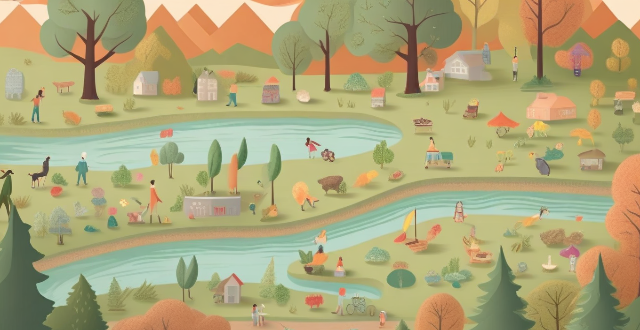Climate change has significant impacts on migration patterns, affecting routes, timing, and even causing species displacement. Traditional migration pathways become unviable due to rising temperatures and shifting habitats. Altered seasonality disrupts the synchrony between migration events and ecological processes like plant blooming or insect emergence. In extreme cases, species may be forced out of their native ranges entirely. Mitigating strategies include habitat protection, climate change mitigation efforts, adaptation strategies, research and monitoring, and public awareness campaigns.

How Climate Change Affects Migration Patterns
Climate change is a global phenomenon that has far-reaching consequences on various aspects of life, including migration patterns. As the Earth's temperature rises and weather patterns become more unpredictable, many species are forced to adapt or move to new habitats in search of suitable living conditions. This can lead to changes in migration routes, timing, and even the complete displacement of certain species. In this article, we will explore how climate change affects migration patterns and what steps can be taken to mitigate its impact.
Impact on Migration Routes
One of the most significant effects of climate change on migration patterns is the alteration of traditional routes. Many animals rely on specific pathways to reach their breeding grounds or wintering areas, but as temperatures rise and habitats shift, these routes may no longer be viable. For example:
- Arctic Sea Ice: Polar bears depend on sea ice for hunting seals, which are their primary food source. As Arctic sea ice melts due to global warming, polar bears are forced to swim longer distances between patches of ice or move into new territories where they compete with other predators for food. This not only affects their migration patterns but also threatens their survival.
- Monarch Butterflies: These iconic insects undertake one of the longest migrations in the animal kingdom, traveling from Canada to Mexico each year. However, rising temperatures in their Canadian breeding grounds have led to earlier spring arrivals and shorter periods of ice cover, disrupting the timing of their migration and potentially causing them to miss critical nectar sources along the way.
Changes in Timing
Climate change can also affect the timing of migration events, such as when animals begin their journey or when they return from it. Altered seasonality due to climate change can cause mismatches between the timing of migration and key ecological processes like flowering plants or insect emergence, which can have cascading effects on entire ecosystems. For instance:
- Bird Migration: Many bird species time their migration based on photoperiod (day length) cues. However, if warmer temperatures cause plants to bloom earlier than usual, birds that rely on those plants for food may arrive too late to take advantage of the abundant resources. This can lead to reduced reproductive success and population declines.
- Amphibian Migration: Some amphibians, like frogs and salamanders, use rainfall patterns as cues for their migration to breeding sites. Changes in precipitation patterns due to climate change can disrupt this process, resulting in either failed breeding attempts or increased exposure to predators during unfavorable weather conditions.
Displacement of Species
In extreme cases, climate change can force species out of their native ranges entirely, leading to displacement and even extinction. As temperatures rise and habitats become unsuitable, some animals may have no choice but to move into new regions where they face competition with resident species and potentially introduce new diseases or parasites. Examples include:
- Reef-Building Corals: Rising ocean temperatures cause coral bleaching events that kill off coral colonies. With repeated bleaching events due to global warming, some coral species are being pushed beyond their thermal limits and are forced to relocate to cooler waters further away from their original habitats.
- Tree Species: As temperatures increase and droughts become more frequent, tree species that are adapted to cooler, moister conditions may struggle to survive in their current locations. This can lead to shifts in forest composition and potential losses of biodiversity as less resilient species are replaced by more heat-tolerant ones.
Mitigating the Impact of Climate Change on Migration Patterns
To address the impacts of climate change on migration patterns, several strategies can be employed at both local and global scales:
1. Habitat Protection and Restoration: Preserving existing habitats and restoring degraded ones can provide safe havens for migrating species and help maintain ecological connections between different parts of their range.
2. Climate Change Mitigation Efforts: Reducing greenhouse gas emissions through renewable energy sources, energy efficiency improvements, and other measures can slow down the rate of climate change and minimize its impact on migration patterns.
3. Adaptation Strategies: Developing management plans that account for changing environmental conditions can help species adjust to new circumstances without compromising their overall health or survival prospects.
4. Research and Monitoring: Continuous research into the effects of climate change on migration patterns is essential for understanding how best to protect affected species and ecosystems. Monitoring programs can track changes over time and inform conservation efforts accordingly.
5. Public Awareness Campaigns: Educating the public about the implications of climate change on migration patterns and biodiversity can foster greater support for conservation initiatives and encourage individual actions that contribute to reducing carbon footprints.
In conclusion, climate change has profound effects on migration patterns across various taxa, from polar bears to monarch butterflies to coral reefs. By understanding these impacts and taking proactive steps to mitigate them, we can work towards preserving the intricate web of life that depends on successful migration for its survival.